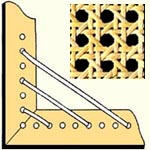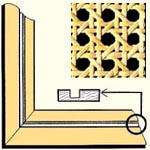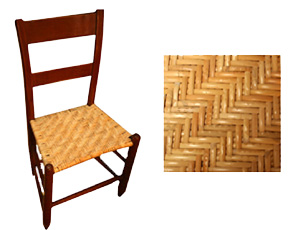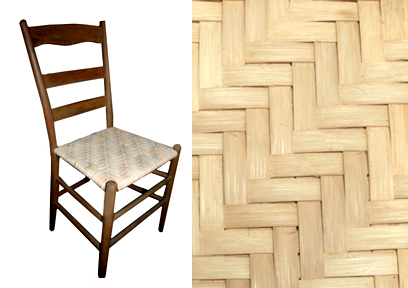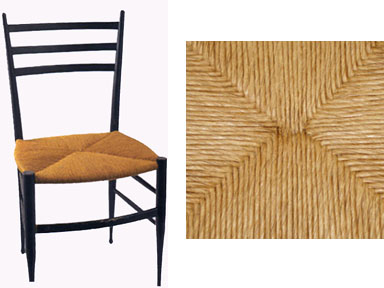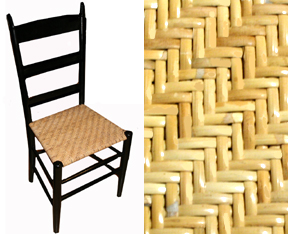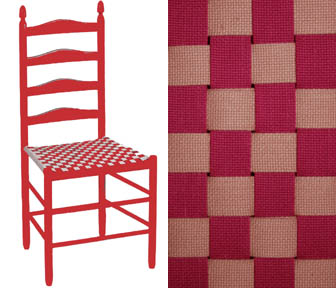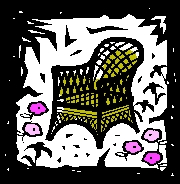What kind of chair cane do you need?
Before you can cane a chair, you need to determine which kind of chair caning method is used, and what kind of chair cane. You've come to the right place!
Review the illustrations and descriptions below to see which fits your chair. If your chair is neither of the first two cane chairs, scroll down to the dowel frame seats for further descriptions and advice.
1. Chair Cane
Please note: The illustration at left, shows drilled holes.
The next illustration below left shows a groove. They're not the same illustration. Two different kinds of caning. Please match to your chair type.
If your chairs has holes, the Chair Cane Kits and Chair Cane pages have a Table for determining the correct size for your project.
Buy chair cane and a Chair Caning booklet with completely illustrated how-to's. Get this booklet when you're weaving a seat with drilled holes in frame.
OR, buy a Chair Cane Kit to get everything you need for one chair with Drilled Holes.
2. Cane Webbing
Use Pre-woven cane webbing for chair seats (shown in traditional hexagonal openwork pattern) for chairs that have a groove around the perimeter of the chair, as shown at left.
When you buy the cane webbing at www.seatweaving.com, we include free instructions to show you how to install this easy-to-work-with cane.
Go to our Cane Webbing page where you can buy the cane webbing by the foot, or buy a KIT for cane webbing- easy to purchase when you only need enough for 1 chair. It includes cane webbing, wedges and spline plus easy instructions.
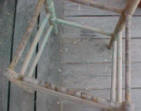
Does your chair have "rails" or "dowels" around the seat?
(Rails, rungs, dowels or horizontal bars, as shown in photo at left.)
If your chair is this style, you can use reed, binder cane, ash or fiber rush.
Below, see 7 examples of chair weaving styles and materials for chairs with dowel or rung construction.
*Remember to totally restore the chair before your weave the seat. Weaving the seat is the last step in finishing the chair.
CLICK on the IMAGES and you will be taken to the booklet page with a CLOSE-UP VIEW.
Finger Lakes Fan Weave booklet, completely illustrated how-to's. Suitable for porch chairs, dining room chairs.
Use wide binder cane or 3/16 to 1/4 flat oval.
1 pound of reed will weave this seat.
Or, one 500' hank of wide binder cane in your choice of 4mm, 5mm or 6mm widths.
New England Porchweave booklet, completely illustrated how-to's. Get this booklet when re-weaving a porch rocker type in plain-weave with Wide Binding Cane or narrow flat reeds.
If the weavers are narrow, 3/16" or 1/4" and have a shiny, bark-like appearance, that's binder cane. Porch-weave pattern is best for this.
It comes in 4 mm, 5 mm and 6 mm widths. 1 hank of binder cane is needed for the seat. 2 coils or hanks for the back.
1/4" flat reed can also be used (3 lb), but it will not be suitable for outdoors.
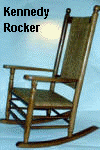
Kennedy Rockers use the New England Porchweave booklet & three coils of 6 mm Binder Cane for seat & back.
Splint Weaving booklet, completely illustrated how-to's. Get this booklet for re-weaving chairs in herringbone pattern with 1/2" flat reeds or 1/2" ash. The pattern is herringbone-type. You can also use 3/8" flat reed, 5/8" flat reed or 1" ash.
1 to 2 pounds of 1/2" (or 3/8" or 5/8") flat reed will weave this seat.
Or, 144' of 1/2" wide ash,
Or, 90' of 1" wide ash.
(Ash is sold in 40' and 60' coils. See our ash splints page.)
If your chair has a woven BACK, double the amount of the seat material to have enough for both.
Fiber Rush Seatweaving booklet, completely illustrated how-to's. Get this booklet for fiber rush seatweaving in the pattern at left. Also has all instructions to adjust for chairseats that are not perfect squares.
If you want a twisted paper appearance, it's fiber rush you need. If you want a twisted grass, it's seagrass that you need. Neither is suitable for outdoors.
One 2 lb coil will weave this kind of seat.
Herringbone Weave booklet, completely illustrated how-to's.
for all Binder Cane widths, and Flat Oval reed in 3/16" or 1/4" width.
Use 1 hank, coil or pound for one seat.
Also called "twill weave" in some parts of the US.
Shaker Tape seatweaving booklet. Completely illustrated.
Suitable for all chairs that have rails around the seat.
Use This Formula
1. Measure the front rail between the posts in inches.
2. Measure from the center of the back rail to the center of the front rail in inches.
3. Multiply these together.
4. Divide the resulting figure by 9 if you're using 1" tape.
Or, divide the resulting figure by 5.3 if your using 5/8" tape. Answer is the number of YARDS needed per chair.
5. Order this number of yards to weave the chair in one color only. Or, order half this amount in each of 2 colors to weave a checkerboard colored chair seat.
Do you have a Wicker Chair that needs repair?
Wicker chairs are usually woven with round reed.
#4 is the most common size. Occasionally you may need other sizes.
Measure the diameter of your material in millimeters before ordering.
To use, simply soak in water for about 1/2 hour and then reweave or
wrap where needed. If your furniture is painted, re-paint it when the reed dries.
Order Round Reed here.
Round Reed Sizes | #0 | #1 | #2 | #3 | #4 | #5 | #6 | #7 | #8 | #9 | #10 |
mm size | 1.25mm | 1.5mm | 1.75mm | 2.25mm | 2.75mm | 3.25mm | 4mm | 5.25mm | 5.75mm | 7mm | 8mm |
Approx. Ft. per lb. | 2200 | 1600 | 1130 | 750 | 510 | 360 | 200 | 150 | 110 | 95 | 80 |
